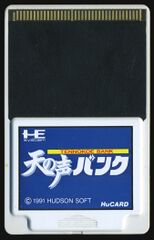Difference between revisions of "Ten no Koe Bank"
From NEC Retro
m |
m (Text replacement - "|prototype=no" to "") |
||
| (One intermediate revision by the same user not shown) | |||
| Line 20: | Line 20: | ||
The Ten no Koe Bank uses a CR2320 "button" battery to retain save data (as opposed to the AA battery solution in the Ten no Koe 2 and the supercapacitor solution used in CD-ROM² hardware). This has its own disadvantage, however, as the battery cannot be replaced without damaging the HuCard shell if it is no longer functional. | The Ten no Koe Bank uses a CR2320 "button" battery to retain save data (as opposed to the AA battery solution in the Ten no Koe 2 and the supercapacitor solution used in CD-ROM² hardware). This has its own disadvantage, however, as the battery cannot be replaced without damaging the HuCard shell if it is no longer functional. | ||
| + | |||
| + | ==Magazine articles== | ||
| + | {{mainArticle|{{PAGENAME}}/Magazine articles}} | ||
==Physical scans== | ==Physical scans== | ||
| Line 37: | Line 40: | ||
===ROM dump status=== | ===ROM dump status=== | ||
{{romtable| | {{romtable| | ||
| − | {{rom|PCE|sha1=8ade1c698e0cb96ce3ed01986c7e5268aa5a1451|md5=e0047b06dc84cb242cced8c5fa7efafe|crc32=3b3808bd|size=128kB|date= |source=Card (JP)|comments=|quality= | + | {{rom|PCE|sha1=8ade1c698e0cb96ce3ed01986c7e5268aa5a1451|md5=e0047b06dc84cb242cced8c5fa7efafe|crc32=3b3808bd|size=128kB|date= |source=Card (JP)|comments=|quality=}} |
}} | }} | ||
Latest revision as of 16:50, 10 April 2024
| Ten no Koe Bank | ||||||||||
|---|---|---|---|---|---|---|---|---|---|---|
| Made for: PC Engine | ||||||||||
| Manufacturer: NEC Home Electronics | ||||||||||
| Type: Storage | ||||||||||
|
The Ten no Koe Bank (天の声バンク) is a device released by Hudson Soft to store save data from PC Engine HuCard and CD-ROM² games.
Contents
Hardware
The Ten no Koe Bank offers 8kB of save data (or 8,000 blocks) - four times the number of the standard CD-ROM² unit, and is presented in HuCard form, meaning unlike previous storage solutions, it does not need access to the PC Engine's expansion slot.
When inserted into the PC Engine's HuCard slot, its proprietary software is booted when powering on the console, allowing the user to manage their data. It can copy data from and to the CD-ROM² unit's backup RAM or a Ten no Koe 2, or exchange data between the system, keeping its data in one of four "boxes" on the HuCard. As the device uses the HuCard slot and boots into its own software when used, no games can access it directly - data saved on the device will need to be transferred to the console in order for games to use it.
The Ten no Koe Bank uses a CR2320 "button" battery to retain save data (as opposed to the AA battery solution in the Ten no Koe 2 and the supercapacitor solution used in CD-ROM² hardware). This has its own disadvantage, however, as the battery cannot be replaced without damaging the HuCard shell if it is no longer functional.
Magazine articles
- Main article: Ten no Koe Bank/Magazine articles.
Physical scans
| PC Engine, JP |
|---|
|
Technical information
ROM dump status
| System | Hash | Size | Build Date | Source | Comments | |||||||||
|---|---|---|---|---|---|---|---|---|---|---|---|---|---|---|
| ? |
|
128kB | Card (JP) |
References
| PC Engine |
|---|
| PC Engine (1987) | CoreGrafx (1989) | CoreGrafx II (1991) X1 Twin (1987) | PC-KD863G (1988) | Shuttle (1989) | GT (1990) | LT (1991) |
| Add-Ons |
| AV Booster (1988) | Interface Unit (1988) | Ten no Koe 2 (1989) | Backup Booster (1989) | Backup Booster II (1989) | Ten no Koe Bank (1991) | Memory Base 128 (1993) |

